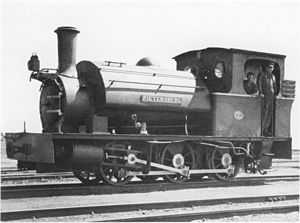PPR 26 Tonner 0-6-0ST
| PPR 26 Tonner 0-6-0ST | |
|---|---|
|
Pretoria-Pietersburg Railway's "Pietersburg", circa 1940 | |
| Type and origin | |
| Power type | Steam |
| Designer | Hawthorn, Leslie and Company |
| Builder | Hawthorn, Leslie and Company |
| Serial number | 2346, 2369, 2370 |
| Build date | 1896-1897 |
| Total produced | 3 |
| Specifications | |
| Configuration | 0-6-0ST |
| Gauge | 3 ft 6 in (1,067 mm) Cape gauge |
| Driver diameter | 42 in (1,070 mm) |
| Wheelbase | 10 ft 5 1⁄2 in (3.188 m) |
| Length | 25 ft 0 1⁄2 in (7.633 m) over buffers |
| Height | 11 ft 1 3⁄4 in (3.397 m) |
| Axle load | 9 6⁄20 long tons (9.4 t) centre driver |
| Weight on drivers | 26 long tons (26 t) |
| Locomotive weight | 26 long tons (26 t) w/o |
| Fuel type | Coal |
| Fuel capacity | 1 10⁄20 long tons (1.5 t) |
| Water capacity | 620 imp gal (2,800 l; 740 US gal) |
| Boiler |
3 ft 4 in (1.016 m) inside diameter 8 ft 10 5⁄16 in (2.700 m) inside length 5 ft 10 in (1.778 m) pitch |
| Boiler pressure | 140 psi (965 kPa) |
| Firegrate area | 8.3 sq ft (0.771 m2) |
| Heating surface: – Tubes |
130 tubes 1 3⁄4 in (44.4 mm) diameter 527.9 sq ft (49.044 m2) |
| – Firebox | 48.7 sq ft (4.524 m2) |
| – Total | 576.6 sq ft (53.568 m2) |
| Cylinders | Two |
| Cylinder size |
14 in (356 mm) bore 20 in (508 mm) stroke |
| Valve gear | Stephenson |
| Performance figures | |
| Tractive effort | 9,800 lbf (44 kN) at 75% pressure |
| Career | |
| Operator(s) |
Pretoria-Pietersburg Railway NZASM Imperial Military Railways Central South African Railways South African Railways |
| Class | PPR 26 Tonner |
| Number in class | 3 |
| Official name | Pretoria, Pietersburg & Nylstroom |
| Delivered | 1896-1897 |
| First run | 1896 [1][2] |
| For lack of a classification these locomotives are referred to as 26 Tonners since the NZASM, who took possession of the PPR, classified its own locomotives according to their weight | |
The PPR 26 Tonner 0-6-0ST of 1896 is a South African steam locomotive from the pre-Union era in the Transvaal.
In 1896 and 1897 the Pretoria-Pietersburg Railway in the Zuid-Afrikaansche Republiek placed three 26 Tonner saddle-tank locomotives with a 0-6-0 wheel arrangement in service. These locomotives were not classified and since all three were named, they were referred to by name.[1]
The Pretoria-Pietersburg Railway
The Pretoria-Pietersburg Railway Company (PPR), incorporated in London on 13 May 1896 with a capital of £500,000, constructed a railway that operated northward from Pretoria West via Warmbad and Nylstroom to Pietersburg. The 176 miles (283 kilometres) line was constructed under a concession granted by the government of the Zuid-Afrikaansche Republiek (ZAR) to Hendrik Jacobus Schoeman on 30 October 1895. Construction commenced in 1897 and the first 80 miles (130 kilometres) to Nylstroom was opened to traffic by 1 July 1898. Pietersburg was reached on 31 May 1899.[1]
Manufacturer
The first locomotives of the PPR were three 26 Tonner 0-6-0 saddle-tank engines that were built by Hawthorn, Leslie and Company, one in 1896 and the other two in 1897. They were employed as construction locomotives while the line was being built and were not classified or numbered, but named "Pretoria", "Pietersburg" and "Nylstroom".[1]
Service
NZASM
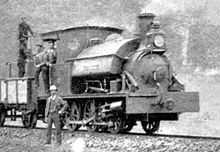
As a result of the outbreak of the South African War in 1899 and since the PPR was owned by a British registered company, the railway and its rolling stock was seized by the ZAR government in October 1899, only five months after the line was completed to Pietersburg. The line was then worked briefly by the Nederlandsche-Zuid-Afrikaansche Spoorweg-Maatschappij (NZASM) until that railway was itself seized by the invading British military forces by the end of the same year.[1][3]
Imperial Military Railways
All railway operations in the two Boer Republics, the ZAR and the Orange Free State, were taken over by the Imperial Military Railways (IMR) in 1899 and operated by the invading military for the duration of the war.[3]
Central South African Railways
At least two of the three locomotives survived the war. At the end of the war the IMR was transformed into the Central South African Railways (CSAR).[1]
South African Railways
The Union of South Africa was established on 31 May 1910, in terms of the South Africa Act. One of the clauses in the Act required that the three Colonial Government railways, the Cape Government Railways, the Natal Government Railways and the CSAR, also be united under one single administration to control and administer the railways, ports and harbours of the Union. While the South African Railways (SAR) came into existence in 1910, the actual classification and renumbering of all the rolling stock of the three constituent railways required careful planning and was only implemented with effect from 1 January 1912.[3][4]
Two of the locomotives, the engines Nylstroom and Pietersburg, survived in railway service to be taken onto the SAR roster in 1912. Since they were considered obsolete, they were excluded from the SAR classification and renumbering list. In spite of being obsolete both of them survived in SAR service into the 1940s, employed as shunting locomotives at the SAR’s Pretoria workshops.[2][4]
Upon their eventual retirement, the engines Nylstroom and Pietersburg were plinthed on the Nylstroom and Pietersburg stations.[1]
Works numbers
The 26 Tonner names, works numbers and years built are as follows:[1]
- The engine Pretoria - 2346 of 1896.
- The engine Pietersburg - 2369 of 1897.
- The engine Nylstroom - 2370 of 1897.
The class illustrated
All three 26 Tonner locomotives are illustrated in the following photographs.
-
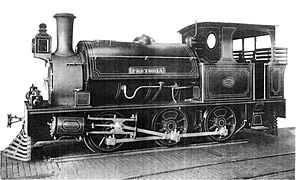
Hawthorn Leslie builder's picture of the engine Pretoria, circa 1896
-
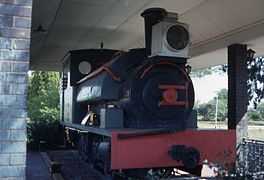
The engine Nylstroom plinthed at Nylstroom station, 28 April 1992
-
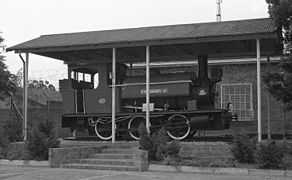
The engine Pietersburg plinthed at Pietersburg station, 3 February 1992
See also
- List of South African locomotive classes
- South African locomotive history
- The 0-6-0 wheel arrangement
References
|
- ↑ 1.0 1.1 1.2 1.3 1.4 1.5 1.6 1.7 Holland, D.F. (1971). Steam Locomotives of the South African Railways, Volume 1: 1859-1910 (1st ed.). Newton Abbott, Devon: David & Charles. pp. 118–119. ISBN 978-0-7153-5382-0.
- ↑ 2.0 2.1 Paxton, Leith; Bourne, David (1985). Locomotives of the South African Railways (1st ed.). Cape Town: Struik. pp. 23–24. ISBN 0869772112.
- ↑ 3.0 3.1 3.2 The South African Railways - Historical Survey. Editor George Hart, Publisher Bill Hart, Sponsored by Dorbyl Ltd., Published c. 1978, pp. 20, 22-23, 25.
- ↑ 4.0 4.1 Classification of S.A.R. Engines with Renumbering Lists, issued by the Chief Mechanical Engineer’s Office, Pretoria, January 1912, p. 2 (Reprinted in April 1987 by SATS Museum, R.3125-6/9/11-1000)
